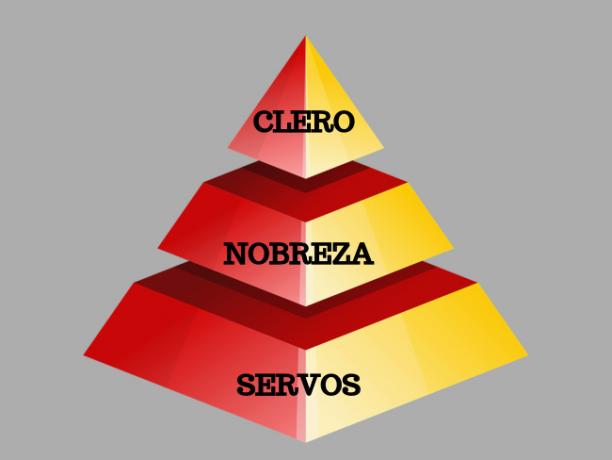Feudalism was a form of organization political, economic, social and cultural that emerged in Europe in the fifth century, after the fall of the Roman Empire, and which was based on land ownership.
In this type of organization, feudal lords (land owners) had rural workers as their servants.
Check out the main characteristics of feudalism below.
1. Feudal society was divided into three social classes

Hierarchy of social classes in feudalism
Feudal society encompassed three social strata: nobility, clergy and servants.
O clergy he was responsible for valuing the spirituality of the feudal community.
THE nobility it was composed of the king and the nobles.
The nobles, also called feudal lords, made constant negotiations with the king in exchange for land and were responsible for managing political, economic and legal powers.
If on the one hand the majority of the population was illiterate, the children of nobles were the only ones who had the right to literacy.
You servants, in turn, constituted the bulk of the peasant community and were generally rural workers.
Learn about the meanings of clergy and nobility .
2. There was no mobility between social classes
The existing social layers in feudalism were considered watertight.
For this reason, those who were born into a certain social class would most likely remain there for the rest of their lives.
3. The lower social classes were subordinated to the higher classes
The serfs, the lowest social class in feudalism, generally received land for cultivation from the feudal lords.
The ceding was made with the sole intention that the lands would be cultivated and that, with that, a bond of serfs relationship with the nobles would be created.
This caused the servants to develop a bond of fidelity, obedience and subordination.
These lands were owned by feudal lords and at no time were they owned by serfs.
4. There were suzerainty relations between the nobles
When the transfer of goods was made from one nobleman to another, the author of the donation was called lord.
This donation of assets does not necessarily indicate the donation of land. The use of certain agricultural equipment, exemption from payment of certain taxes, etc., was often granted.
The nobleman who benefited from the donation was given the designation of vassal.
As a form of retribution, it was up to the vassal to take an oath of allegiance to the suzerain, if committing, for example, to fight in his army in case he is called up and to help him financially if necessary.
Learn more about the meaning of vassal.
5. The feudal economy was based on self-sufficient agricultural production.

Agriculture in the period of feudalism
During feudalism, the activity of marketing products was not a common practice.
The economy of the manor, the main economic unit, was based on a subsistence farming, that is, farmers produced to ensure their own livelihood.
This production was self-sufficient and for that reason it was not necessary to resort to other producers; the quantity of what was produced by the farmers was enough for them. Any and all surplus production was taken by feudal lords.
As monetary exchange did not exist, the fiefs exchanged among themselves the products they needed, but which they did not produce.
See the meaning of fief.
6. The legal, political and economic powers were monopolized by the feudal lord
Although the king was the ultimate authority, feudal lords (also called nobles) received many privileges from the monarchy. These privileges were compensated with military assistance from the nobles to the king.
Thus, they began to have decision-making power over matters in the legal, political and economic domain.
The nobles had, for example, autonomy to create laws, manage justice, form private armies and declare wars.
7. The Catholic Church had a strong influence during feudalism
The Catholic Church was the most powerful feudal institution.
She had a great influence on the economic landscape of the manor due to the fact that she owned many lands.
This influence ended up being reflected in the way of thinking of people, who considered that priests established a link between God and men.
8. Land acquisition could stem from wars
When the acquisition of land did not take place through the transfer of the king or feudal lords or through heredity, it was common for them to take place through wars.
Sometimes the reason for these wars was that people who were already landowners wanted to expand their territories.
Another hypothesis was due to the end of the serfs' bond of servitude to the feudal lords.
The fate of land, initially granted to the serf by the feudal lord, was often decided through war.
9. Serfs paid taxes and levies
The relationship of nobles to serfs was based on exploitation.
The serfs worked on the lands ceded by the nobility and because of that, they were obliged to pay taxes.
Some of the main taxes paid were:
- Capitation: tax paid by each family member;
- tithe: 10% of production was paid to the church;
- carving: part of the production should be handed over to the feudal lord;
- Banality: payment that allowed the use of assets from the manor (mills, ovens, roads, etc.).
Curiosities about feudalism
- Feudalism began in western and central Europe, and spread to other parts of the continent;
- Kings believed that they received power from God as monarchs;
- Feudal lords lived in fortified castles situated in the midst of their lands;
- Nobles used to settle their personal matters through duels;
- Women had no rights in feudal society. They couldn't even choose who and when to marry;
- Feudalism prevailed in Europe throughout the Middle Ages. During this period, hygiene habits were so precarious that diseases such as black Plague spread rapidly, almost decimating the European continent.
Learn more about feudalism.

